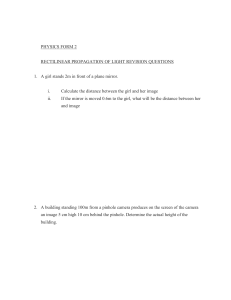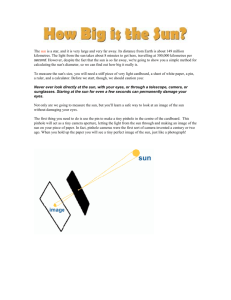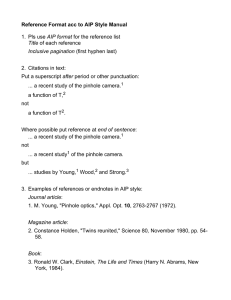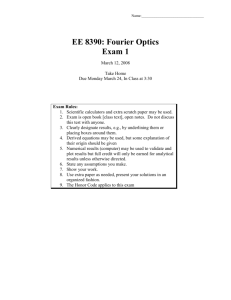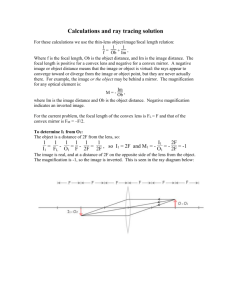Slides
advertisement
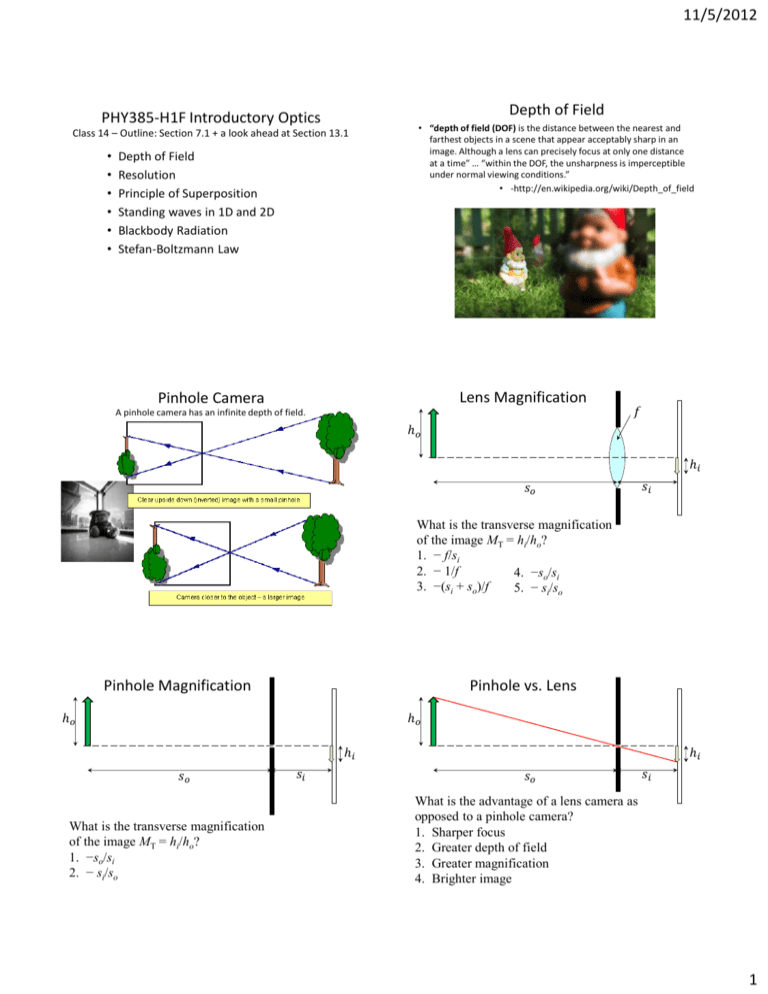
11/5/2012 Depth of Field PHY385-H1F Introductory Optics Class 14 – Outline: Section 7.1 + a look ahead at Section 13.1 • • • • • • Depth of Field Resolution Principle of Superposition Standing waves in 1D and 2D Blackbody Radiation Stefan-Boltzmann Law • “depth of field (DOF) is the distance between the nearest and farthest objects in a scene that appear acceptably sharp in an image. Although a lens can precisely focus at only one distance at a time” … “within the DOF, the unsharpness is imperceptible under normal viewing conditions.” • -http://en.wikipedia.org/wiki/Depth_of_field Lens Magnification Pinhole Camera A pinhole camera has an infinite depth of field. 𝑓 ℎ𝑜 ℎ𝑖 𝑠𝑜 𝑠𝑖 What is the transverse magnification of the image MT = hi/ho? 1. − f/si 2. − 1/f 4. −so/si 3. −(si + so)/f 5. − si/so Pinhole Magnification Pinhole vs. Lens ℎ𝑜 ℎ𝑜 ℎ𝑖 𝑠𝑜 What is the transverse magnification of the image MT = hi/ho? 1. −so/si 2. − si/so 𝑠𝑖 ℎ𝑖 𝑠𝑜 𝑠𝑖 What is the advantage of a lens camera as opposed to a pinhole camera? 1. Sharper focus 2. Greater depth of field 3. Greater magnification 4. Brighter image 1 11/5/2012 Depth of Field Pinhole Camera • “depth of field (DOF) is the distance between the nearest and farthest objects in a scene that appear acceptably sharp in an image. Although a lens can precisely focus at only one distance at a time” … “within the DOF, the unsharpness is imperceptible under normal viewing conditions.” • -http://en.wikipedia.org/wiki/Depth_of_field A pinhole camera has an infinite depth of field. Test on Tuesday Nov. 6 • The 50 minute test on Tuesday, Nov. 6 will contain 6 multiple choice questions, and 3 long-answer questions • This test will cover all of Hecht Chapter 5, plus the sub-sections we covered in Chapter 7 and Chapter 13. • As with test 1, the allowed aids include your calculator and a single 8.5x11” aid sheet, doublesided. • Also don’t forget – problem set 4 is due on Thursday (2 days from now!) Laser Resonant Cavity Astronomical Seeing Kirchhoff’s Thermal Radiation Analysis 1859 • 𝜀𝜆 = emission coefficient • 𝜀𝜆 = the energy per unit area per unit time emitted in a tiny wavelength range around λ • Units of 𝜀𝜆 are [W / m2 nm] • 𝛼𝜆 = absorption coefficient • 𝛼𝜆 = the fraction of the incident irradiance absorbed per unit area per unit time in that wavelength range • 𝛼𝜆 is dimensionless 2 11/5/2012 Absorption Coefficient • What are the absorption coefficients 𝛼𝜆 for a perfect mirror and a perfectly white piece of paper? 1. 1 for the mirror, 1 for the paper 2. 0 for the mirror, 1 for the paper 3. 1 for the mirror, 0 for the paper 4. 0 for the mirror, 0 for the paper Blackbody Radiation I 2hc 2 1 hc 5 e kT 1 Blackbody Radiation 3
